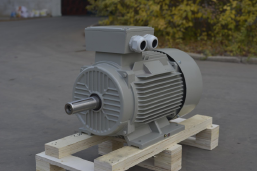- The Working Principle Of An Asynchronous Motor
The working principle of an asynchronous motor (induction motor) is to generate an induced current in the rotor through the rotating magnetic field of the stator, generating an electromagnetic moment, and the rotor does not directly generate a magnetic field. Therefore, the rotor speed must be less than the synchronous speed (without this difference, that is, the slip rate, there is no rotor induced current), so it is called an asynchronous motor.
And "three-phase asynchronous motor", three-phase means that the voltage is three-phase electricity, and the power supply mode is 120° electrical angle to generate an alternating magnetic field, which drives the motor to work. Three-phase means three-phase AC. Asynchronous means relatively synchronous. The rotor speed is not equal to the synchronous speed and forms a certain difference. The relevant parameters refer to the slip rate. The fundamental difference between synchronization and asynchronous is whether there is excitation or not. The asynchronous motor generates electric potential on the rotor by electromagnetic induction to form a current, and rotates by the force of the magnetic field under the magnetic field formed by the stator. Therefore, the first condition is that there is slip. Will cut the magnetic field, will produce force. The "asynchronous" meaning of a three-phase asynchronous motor is that the speed of the rotor is always lower than the synchronous speed in the electric working state.
The rotor speed of the three-phase asynchronous motor will not be synchronized with the rotating magnetic field, let alone exceed the speed of the rotating magnetic field. Because the induced current in the rotor coil is caused by the relative movement of the rotor conductor and the magnetic field. If the rotation speed of the rotor is equal to the rotation speed of the rotating magnetic field, then there is no relative movement between the magnetic field and the rotor, and the conductor cannot cut the magnetic lines of force. Therefore, no induced electric potential and current will be generated in the rotor coil, and the rotor conductor is in the magnetic field. Therefore, the rotor will not be rotated by the electromagnetic force. Therefore, the rotor rotation speed of the asynchronous motor cannot be the same as the rotating magnetic field, and is always less than the synchronous speed of the rotating magnetic field. However, in special operating modes (such as dynamic braking), the rotor speed can be greater than the synchronous speed. Because the rotor and stator rotating magnetic fields of a three-phase asynchronous motor rotate in the same direction and at different speeds, it is called a three-phase asynchronous motor instead of a three-phase synchronous motor.
A three-phase asynchronous motor that operates as a motor. The speed of the rotor of the three-phase asynchronous motor is lower than the speed of the rotating magnetic field. The rotor winding generates electromotive force and current due to the relative movement between the magnetic field and the magnetic field, and interacts with the magnetic field to generate electromagnetic torque to realize energy conversion.
- Three-Phase Asynchronous Motors Advantage
Compared with single-phase asynchronous motors, three-phase asynchronous motors have better running performance and can save various materials. According to different rotor structures, three-phase asynchronous motors can be divided into two types: cage type and winding type. The cage rotor asynchronous motor has simple structure, reliable operation, light weight and low price, and has been widely used. Its main disadvantage is the difficulty of speed regulation. The rotor and stator of the wound three-phase asynchronous motor are also provided with three-phase windings and connected to an external varistor through slip rings and brushes. Adjusting the resistance of the rheostat can improve the starting performance of the motor and adjust the speed of the motor.

 中文
中文 English
English Español
Español Français
Français

